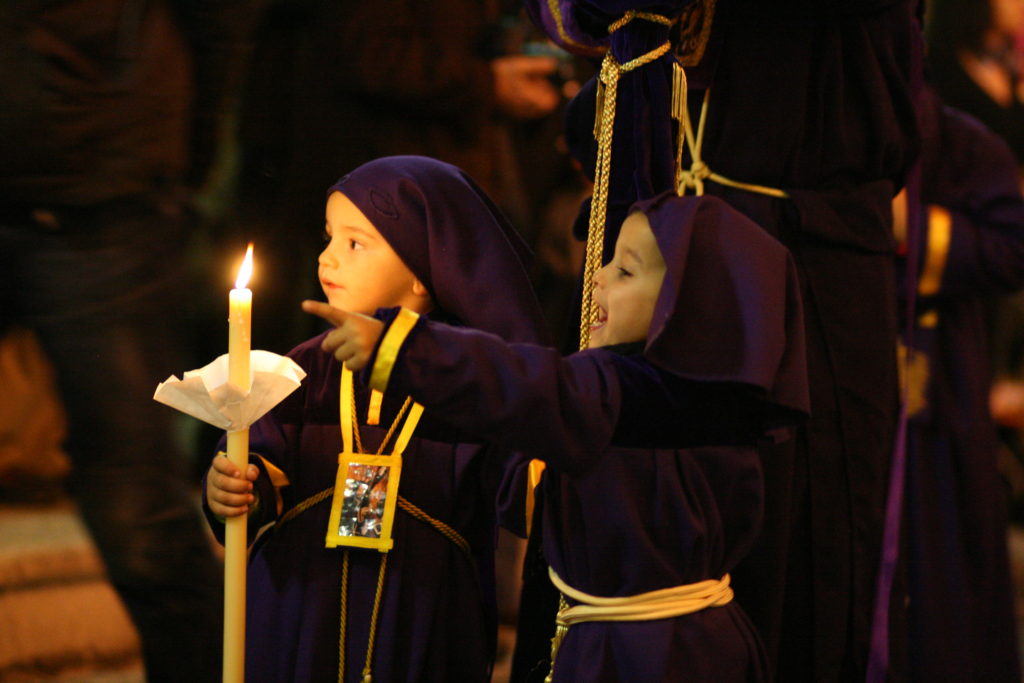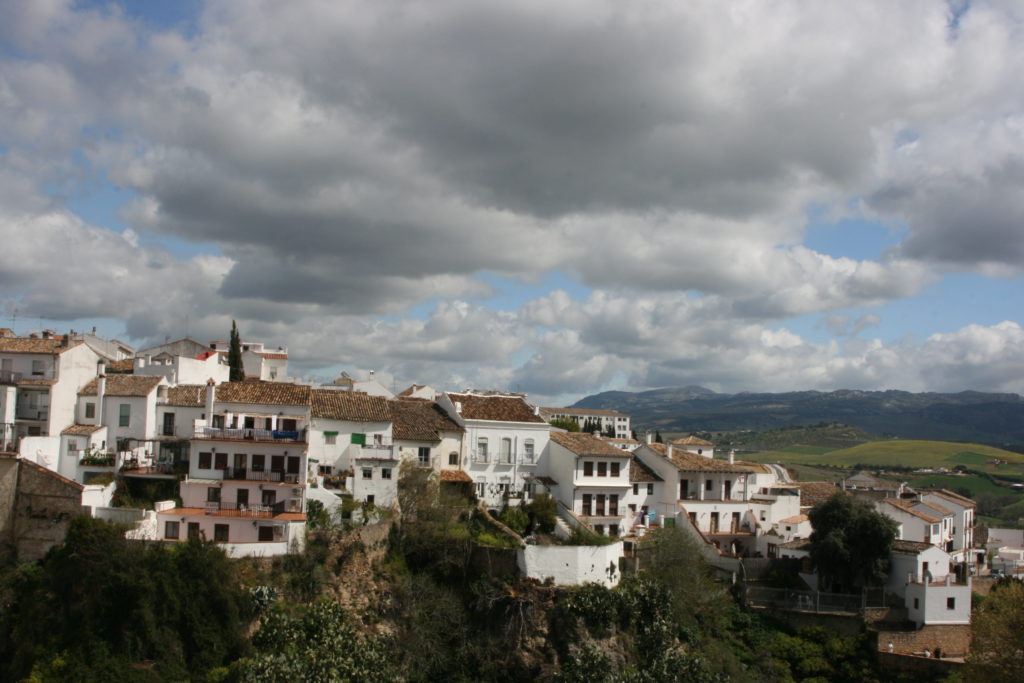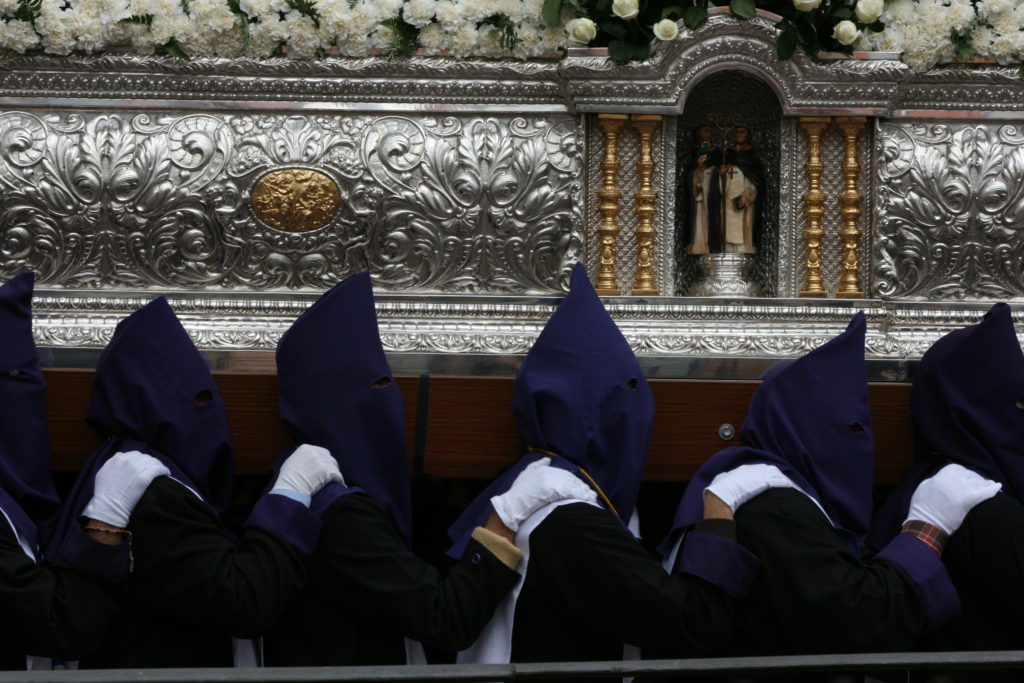
As luck – or rather my immaculate planning – has it, we got here right in time to witness the Easter festivities. Semana Santa, as the week leading up to and culminating in Easter Sunday is called, is a highpoint of the year in this strictly catholic part of the world.
Basically all week there are processions in every town, village, city, hamlet where mostly man clad in black or purple robes carry around huge carved figurines of Jesus carrying the cross or nailed to the cross and always also a solemnly beautiful Virgin Mary in an outfit that seems completely unsuited to the climate in Palestine – or Andalucía for that matter.
The robes of the revelers are eerie, scary even, as they hide the face completely only leaving small slits for the eyes. Here in Frigiliana, they have an opaque veil in front of the face but the ones we saw today in Ronda – which are the most common ones – have a pointed hood which make them look like Ku Klux Klan outfits. Only they are not and, these outfits predate the KKK’s by centuries.
The tradition of these processions dates back to the 15th century when the Catholic Church was desperately looking for ways to keep their flock together and out of the reach of the heretic new movements within the church. Since most people were unable to read or write putting on a big spectacle during the week leading up to Easter seemed like a good idea and I guess it was, as it is still done today and from the smallest kids to the old ones everybody participates. The reason for the hoods is that in the 14th century some pope had the – in my opinion entirely reasonable – idea (rare for a pope) to prohibit any public display of self-flagellation. Since the desire for self-flagellation seemed to have run deep they came up with the idea to hide their faces and do it anyway. The hoods are still part of the tradition today, the self-flagellation, though, seems to have lost its appeal.
The processions happen during the day and night in total silence only with the occasional band playing solemn music. Even the little kids behave fairly well and are quiet and concentrate real hard not to stumble over the long veils of the guys marching in front of them. During the night processions the participants carry candles and at least here in Frigiliana they turned off the lights in the entire town for a better effect. It was quite something to see a bunch of pretty unfit guys carry the heavy wooden figurines and displays on their shoulders up steep Calle Alta, carefully bending down to avoid the low hanging wires and maneuvering tight corners. After Jesus carrying the cross came the 12 apostles and an assortment of other characters I didn’t identify right away like a couple of guys in a yellow top, baby-blue skirt and bright red stockings carrying a lancet – well on second thought those were probably evil Romans.

Yesterday Annette and I made our way down to the church and watched the procession as it left the church and started it’s way up Calle Alta, then cut across trying to outrun them on an alternate route to get home and on the balcony overlooking the Calle but we where too slow. So tonight we are sitting tight waiting for the spectacle to come by our doorsteps.

This morning we piled in the car early and drove up to Ronda, an old city sitting high up in the Sierra about 50 km from Marbella. Its location is spectacular on two sides of a huge gorge which is connected by three bridges, the Roman, the Arabic and the “New” which itself is older than pretty much all of the buildings in the US. Max was particularly interested in the New Bridge as it is huge and spans the gorge at its deepest part. The views are amazing, especially for a person like me, still plagued by vertigo after all these years of rock climbing. The town was bustling but for once it seemed to be mostly Spanish tourists up here in the rough climate of the mountains and not the Germans and Brits who seem to prefer to sit in huge hotel or apartment complexes and drive the short distance to Frigiliana and other towns like it for their fill of local flair and culture.

We happened to come across yet another procession, this one with people wearing purple robes and pointy hoods. They seemed a little more professional than our guys in Frigiliana. They marched in perfect lock-step with the huge display of Mary crying with the dead Jesus on her lap only slightly swaying. They had it easier, though, at least the part I saw as the roads they walked on were fairly flat. People were out in force and since we didn’t line up I didn’t get a good photo spot which had me desperate for a while. The badge-waving trick doesn’t work quite as well here as it did in Merida but I finally wiggled my way through to the front sitting on the ground and taking a few shots before heading out – it was way past lunch time and even Max, who never complains of hunger, unless he is whining for candy, was expressing a desire to “eat something”. It would have been nice to have a little more time but after the late lunch we walked back to our car watching a bit more of the procession and soaking in a bit more of the white town against the dramatic dark clouds. Max fell asleep in the car before he his chocolate cookie was even halfway eaten – that should tell you something.
Now I am sitting by the fireplace waiting for the procession to come by, jumping up every few minutes and looking out onto the Calle – as the procession happens in utter silence there is no way of knowing when they will be coming by but I don’t want to miss it. The camera is loaded with a new compact flash, the fast lens is on, ISO 1600 set, so I am ready and I won’t use my flash – another pet-peeve of mine: if one intrudes on people’s ceremonies at least one should do it in a respectful way and not flash some bright light into their faces. Oh, the church bell is chiming – gotta go!
